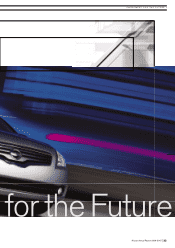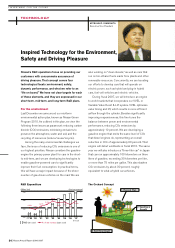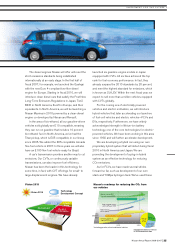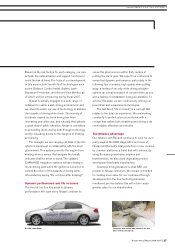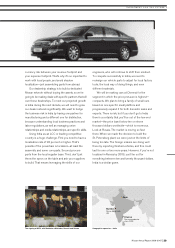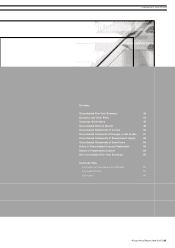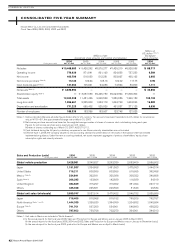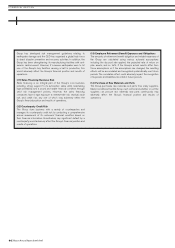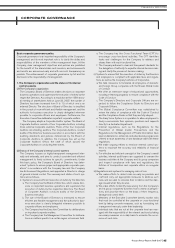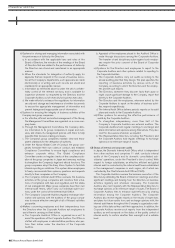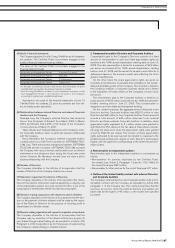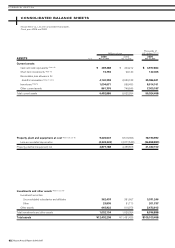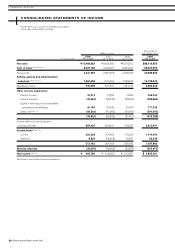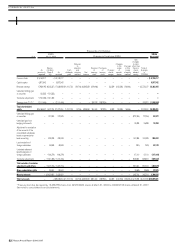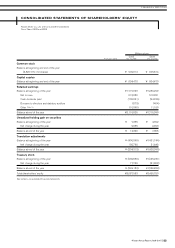Nissan 2007 Annual Report Download - page 45
Download and view the complete annual report
Please find page 45 of the 2007 Nissan annual report below. You can navigate through the pages in the report by either clicking on the pages listed below, or by using the keyword search tool below to find specific information within the annual report.
With regard to disclosure in the Business Overview, Financial
Information and other parts of this Securities Report, the
salient items which may affect the decisions of our investors
can be grouped under the following risk factors.
Any future forecasts included in the following descriptions
are based on the estimates or judgment of Nissan as of June
25, 2007.
(1) Economic Factors
The demand for products manufactured by the Group is affected by
the economic conditions in each country or market in which they are
offered for sale. The Group conducts its operations all over the world
and, in particular, in the major markets of North America, Europe and
the Global Overseas Market, to say nothing of Japan. While the
Group strives to develop a comprehensive and integrated projection
of the global economic outlook, any greater-than-anticipated
downturn in one of these markets may have a significant effect on
the Group’s financial position and results of operations.
(2) Risks Involved in International Activities and
Overseas Expansion
The Group’s manufacturing and marketing activities outside Japan
are conducted in the United States, Europe, and general overseas
regions. The Group forecasts and evaluates a wide variety of risks
inherent in doing business in such overseas markets including the
following factors, each of which may entail a greater-than-anticipated
level of risk, thereby causing significant effects on the Group’s
financial position and results of operations:
• Unfavorable political or economic factors
• Legal or regulatory changes
• Potentially adverse tax consequences
• Labor disputes including strikes
• Difficulties in recruiting and retaining personnel
• Social turmoil due to terrorism, war, or other destabilizing factors.
(3) Research and Development
The Group’s technology must be useful, pragmatic and easy to use.
The Group anticipates the nature and scope of the market demand,
and then prioritizes and invests in new technologies. Nonetheless,
any sudden and greater-than-anticipated changes in its business
environment or in customer preferences may impact negatively on
customer satisfaction with these new technologies.
(4) Product Defects
The Group places a high priority on safety and does its best to
enhance safety from the standpoint of research and development,
manufacturing and sales. Although the Group takes out insurance
policies to cover product liability, this does not necessarily mean that
all potential defects and the related liabilities are fully covered. If the
Group were to implement significant recalls in volume and amount for
the benefit of customers’ safety, the Group would incur significant
additional expenses which could adversely affect its financial position
and results of operations.
(5) Fluctuation in Foreign Currency Exchange Rates
The Group’s Japanese operations export vehicles to various countries
around the world. In general, the appreciation of the yen against other
currencies adversely affects the Group’s financial results of
operations and, on the contrary, the depreciation of the yen against
other currencies favorably affects the Group’s financial results of
operations. Any sharp appreciation of the currencies of countries
where the Group manufactures vehicles against the yen could lead to
increases in both procurement and production costs which would
adversely affect the Group’s competitiveness.
(6) Derivatives
The Group utilizes derivative transactions for the purpose of hedging
its exposure to risks such as fluctuations in the foreign exchange
rates of its receivables and payables denominated in foreign
currencies, the interest rates of interest-bearing debt and fluctuations
in commodity prices. While the Group can hedge against these risks
by using derivatives transactions, the Group, by so doing, may miss
the potential gains which could result from seizing the market
opportunities to profit from such fluctuation in exchange rates and
interest rates. In addition, the Group manages its exposure to credit
risk by limiting its counterparties to financial institutions with high
credit ratings. However, a default by any one of these counterparties
could have an adverse effect on the Group’s financial position and
operating results.
(7) Lawsuits and Claims
With respect to various lawsuits and claims which the Group
encounters, the possibility exists that the position defended by the
Group will not be accepted and that the outcome may be significantly
different from that anticipated. As a result, any such verdict or
settlement could adversely affect the Group’s financial position and
operating results.
(8) Government Regulations
The automobile industry worldwide is influenced by a broad spectrum
of regulations governing the emission levels of exhaust fumes, fuel
economy guidelines, noise level limitations and safety standards, and
the Group expects these regulations to become increasingly
stringent. In order to ensure compliance, it may be necessary for the
Group to make significant ongoing investments in these areas which
would have an impact on its financial position and results of
operations.
(9) Intellectual Property Rights
The Group owns a wide variety of proprietary technologies and has
the expertise to differentiate the Group’s products making them
unique from those of its competitors. These assets have proven their
value in the growth of the Group’s business and will, no doubt,
continue to be of value in the future. The Group strives to protect its
intellectual property assets; however, in certain markets, the Group
may encounter difficulty in fully protecting the proprietary rights to its
own technologies.
Although the Company has established Intellectual Property Rights
Management Department since April 2004 for protecting intellectual
property rights in specific areas, strengthening activities to protect
Nissan’s intellectual property rights, and abstracting new intellectual
property rights and has been performing various activities to protect
and create Nissan Brand, cases may arise where the Group finds
itself unable to prohibit others from infringing on its intellectual
property rights.
(10) Natural Disasters
The Group’s corporate headquarters and many of its manufacturing
facilities are located in Japan, where the statistically proven
probability of earthquakes is higher than in many other countries. The
BUSINESS AND OTHER RISKS
Nissan Annual Report 2006-2007 43
FINANCIAL SECTION»


